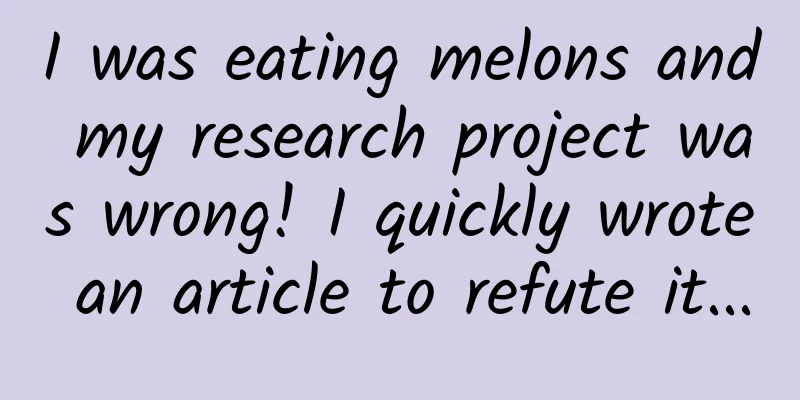I was eating melons and my research project was wrong! I quickly wrote an article to refute it...

|
Some time ago, when I was surfing the Internet, I came across a post that said "Scientists conducted genetic testing on ancient people in Sanxingdui" and so on. When I saw the title, I thought it was related to the project I was working on, so I clicked on it to take a look. Guess what - it was talking about my project, and it was wrong. The paper of this study is called "Ancient genomes reveal millet farming-related diffusion from the Yellow River to southwest China" (the official title is slightly different from the preprint title). However, the samples we studied are not "Sanxingdui people", but from the Gaoshan ancient city site in Sichuan during the Neolithic Age and the Haimenkou site in Yunnan during the Bronze Age. To begin with, what exactly is Sanxingdui? The Sanxingdui ruins can actually be divided into four phases. Among them, the familiar Sanxingdui with bronze masks, grinning mysterious men, bronze standing figures, and bronze sacred trees, to be exact, belongs to Sanxingdui Phase II and Phase III. However, the Sichuan Gaoshan ancient city ruins described in our research sample belong to the Baodun culture, which is older than Sanxingdui. Image source: pixabay To sum it up briefly: the so-called "genetic testing of Sanxingdui ancients" is actually the DNA data of ancient human remains from the ancient city of Baodun culture in Gaoshan that we published. Although some archaeologists do believe that Baodun culture may be the predecessor of Sanxingdui bronze culture, these remains are still more than a thousand years apart from the artworks that people are concerned about, and they are not the makers of those mysterious bronze artifacts. Seeing this, you may want to press the jump button and close this article. Don't leave in a hurry, the value of these data may be much more important than you think. The ancient city of Gaoshan in the Sichuan Plain is known as the first city in Chengdu's history. The earliest human bones in the Chengdu Plain were unearthed; and the Haimenkou site on the Yunnan-Guizhou Plateau unearthed the largest "stilt-style" building settlement in China, which is also one of the birthplaces of Yunnan Bronze Culture. These two archaeological sites are extremely important for understanding the origin of prehistoric populations in the southwest region. But isn't millet the same as sorghum? Sorghum is the non-sticky millet, and sorghum is the sticky millet. Why is millet still used in the study of ancient humans in the southwest? Initially, our ancestors lived by hunting and gathering, relying mainly on the "gifts of nature". Later, our ancestors acquired the ability to cultivate crops and raise animals, and humans entered an agricultural society. In terms of agricultural production, millet and sorghum are mostly grown in the north of my country, while rice is mostly grown in the south. Gaoshan Ancient City and Haimenkou are sites where both millet and rice have been unearthed. Logically, the genetic components of both the northerners who grew millet and the southerners who grew rice should be found in the ancient people here. Information about Gaoshan Ancient City and Haimenkou Ruins Image source: provided by the author However, we found that the ancients of these two sites had about 90% (92.1%±3% in Gaoshancheng and 88.7%±3% in Haimenkou) genetic components of millet farmers in the Yellow River Basin (here refers to the ancients who engaged in agricultural production in the Neolithic Age, the same below), but no genetic components of rice-growing farmers in South China and Southeast Asia were found. The remaining 10% or so belonged to the genetic components related to the ancients of the Laotian Peace Culture (HòaBìnhculture) - this may be the primitive hunter-gatherer population widely distributed in southwest China and the Southeast Asian continent bordering it at that time. This genetic pattern lasted for more than a thousand years from Gaoshan Ancient City to Haimenkou. A high proportion of genetic components related to Gaoshan Ancient City and Haimenkou were also found in contemporary Tibeto-Burman peoples such as the Qiang in Sichuan and the Bai in Yunnan—but there were also some rice farmers' genetic components related to the Zhuang-Dong and Austronesian peoples in Southeast Asia and Fujian, but not found in Gaoshan City and Haimenkou. It is easy to say this conclusion now, but if you look through previous studies, you will find that almost no researchers have published DNA data of ancient people in the Yunnan, Guizhou and Sichuan regions. This situation is not difficult to imagine: the ideal conditions for DNA preservation are dryness and coldness. The Yunnan-Guizhou-Sichuan region is humid and hot, which is not suitable for preserving things. When preserving food, we choose to put it in the refrigerator, or air-dry it in the sun; if it is placed in a warm and humid environment, it will soon rot and deteriorate. The same is true for DNA. High temperatures make molecules more active, and acidic soil creates a good environment for the hydrolysis of DNA. Image source: pixabay In southwestern regions such as Yunnan, Guizhou and Sichuan, some sites are even directly submerged in water. Therefore, the DNA of ancient people preserved in this area is really rare. In fact, our paper also implicitly mentioned this difficulty: a total of 89 samples were extracted in the study, but only data from 11 samples were obtained in the end. How to identify and isolate the human DNA in these samples is another big problem. Our research objects have been buried underground for thousands of years. During these thousands of years, countless organisms have left their traces on the surface and even inside these research objects. In fact, many of the DNA we obtain from ancient biological materials actually come from microorganisms in the environment, such as bacteria and fungi active in the soil attached to bones. They may gradually crawl deeper into the bones over a long period of time, so researchers like to get parts such as teeth or temporal bones: they are solid, dense, and not easily contaminated by exogenous DNA. After excavation, contamination still exists. Bones excavated from archaeological sites usually carry a lot of dirt and dust, and are exposed to a lot of modern human contamination outside the laboratory. Researchers use sodium hypochlorite, which can degrade surface DNA, to clean the samples, and then expose them to ultraviolet light for an hour. In this way, the surface DNA will become undetectable pyrimidine dimers. We will also drill and grind the dense parts of the bones, and try to separate the dirt that penetrates them from the bone powder itself, leaving only the internal bone or pulp. In this way, the "DNA of the tooth or bone itself" can be preserved as much as possible. Even so, the DNA obtained still contains a large amount of microbial DNA, and the "DNA itself" only accounts for a small part. At this time, we have to use the "hybridization capture" technology. The principle is very simple. Two chains composed of four deoxyribonucleotides A, G, C, and T form the double helix structure of DNA. These two chains can be seen as the arrangement and combination of four molecules A, G, C, and T, and they are completely reverse complementary. A is paired with T, and G is paired with C, which is almost error-free. The arrangement and combination of the four molecules are different in each species and even in each individual. We use the DNA sequence of modern people to design probes, and use this probe to capture the required human fragments: it can be understood as a small puzzle hanging on a fishhook to catch the parts of the many DNA puzzles that can be pieced together with it. These parts that can be pieced together are human DNA. Our hybrid capture solution came from a research team at Harvard University. They redesigned the DNA probe and optimized all the experimental conditions in a "violent" way. This solution is one-third cheaper than the previous one, but we still can't afford it. So I can only try to optimize the process and reduce costs. In the end, we saved nearly half of the reagents. The success of the experiment is only the first step. We need to let the data speak for itself. In the preliminary qualitative analysis, I came to a conclusion. With the help of Professor Wang Chuanchao and postdoctoral fellow Guo Jianxin, I checked all possible omissions, supplemented data, checked one by one, and finally confirmed the conclusion: the ancients of the above two sites mainly came from farmers who planted millet and sorghum in the Yellow River Basin, plus a little primitive Southeast Asian hunting and gathering population - perhaps from Yunnan, Guizhou and Sichuan, or perhaps from the northward migration of ancient Southeast Asians. A reasonable speculation is: perhaps some millet farmers in the Yellow River Basin migrated south to the Sichuan Basin and the Yunnan-Guizhou Plateau, and learned to grow rice by interacting with rice farmers on the way. The author of this article works in the laboratory. Image source: provided by the author On the wall of our laboratory, there is a sentence written: "Natural sciences and humanities and social sciences parted ways more than a hundred years ago, and in this laboratory, we hope to bring the two back together." Perhaps this is the meaning and fun of the work we do. As a "biologist" who majored in biology, when I first processed the data, I didn't quite understand how they were fundamentally different from the data of mice, rabbits, or zebrafish that I had processed before. However, when teachers familiar with the fields of history and archaeology used these data to open a historical picture scroll in front of me and guided me to the genetic conclusion that "the ancient Shu and ancient Dian cultures have the same roots as the Yellow River Basin culture", I really felt the passion brought by the integration of disciplines. Previous archaeological evidence has shown that the Majiayao culture is closely related to the western Sichuan region, and our genetic evidence also supports that ancient Shu and ancient Dian have an inseparable genetic connection with the Yellow River Basin civilization, the mother river of Chinese civilization. I began to understand the significance of such an interdisciplinary subject: archaeology teachers use artifacts and written materials to classify people and cultures. They actually need some interpretations from other angles, and molecular biology methods happen to be what biology students like me are good at. I will continue to move forward in this direction. This article is a work of Science Popularization China-Starry Sky Project Produced by: Science Popularization Department of China Association for Science and Technology Producer|China Science and Technology Press Co., Ltd., Beijing Zhongke Xinghe Culture Media Co., Ltd. Author: Tao Le, PhD student at Xiamen University Reviewer: Wang Chuanchao, Director, Professor, and Doctoral Supervisor of the Institute of Anthropology, Xiamen University |
<<: If you gain weight after work, it’s not your fault! You work too hard.
Recommend
Paoxue.com: Wandering Emotion Official Private Tutoring Course Baidu Cloud Course
Features of the Wandering Emotion "Official ...
How to develop an addictive app?
Although there are a total of 5 million apps avai...
Cooling down! Blizzard! Cold front is coming again
The cold air is coming again! November 19-22 Rain...
How to do To B content marketing?
What are the similarities and differences from C ...
Why does the peony become the "national flower" by surpassing the peony?
Although there is no final conclusion, if asked w...
Actual test: Android's built-in Google Play Protect protection capability is useless
According to the latest test results from German ...
Can Huang Zhang help Meizu turn things around this time by promoting new products?
Recently, Meizu has been making a lot of moves. N...
Getting Started with WatchKit: Creating a Simple Guessing Game
Editor's note: As you know, Apple has include...
Teach you step by step to develop APP promotion strategy!
Since the APP of the company I work for is about ...
Pinduoduo’s 5 high-conversion marketing strategies!
Pinduoduo , a new internet celebrity and a three-...
These mobile phone functions and skills can solve holiday battery anxiety
Although there has not been a revolutionary impro...
Is it true that “not eating after noon” can help you lose weight?
Audit expert: Shen Yingjian Director of the Nutri...
The year's "biggest full moon", "super moon" and "blue moon" appear at the same time. How often does such a "special" astronomical phenomenon occur?
I don’t know if you have noticed that this August...
up to date! Traffic rankings of 39 popular information flow platforms!
The December data of major popular information fl...
Market demand rebounds and high-end becomes the development direction of white goods
News from the Ministry of Commerce shows that in ...









